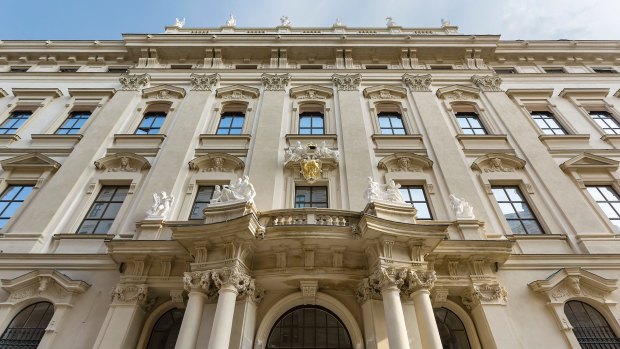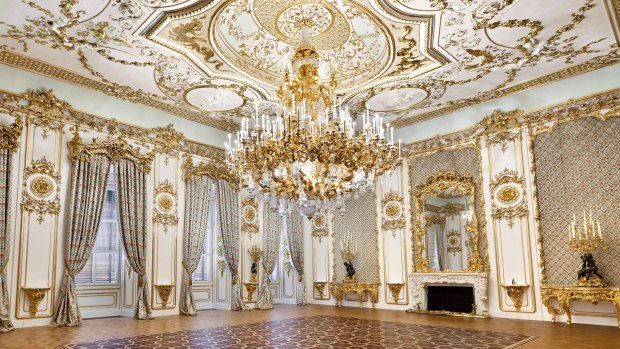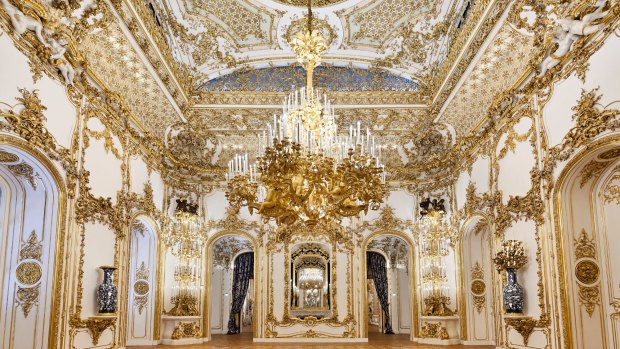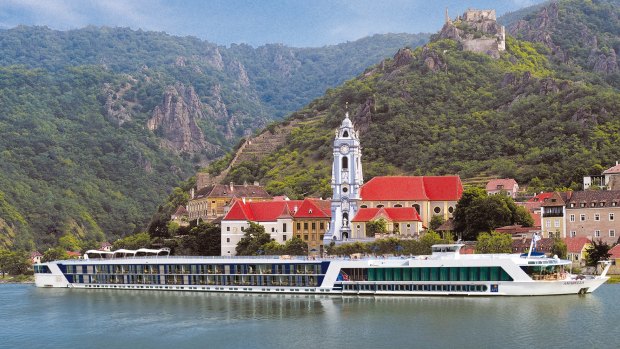This was published 6 years ago
The Palais Liechtenstein: Inside Vienna's renovated palace of princes of Liechtenstein

Palais Liechtenstein in Vienna.Credit: Andreas Gruenwald
The giant baroque crystal and gilt chandelier shivers above us as baritone and soprano voices weave their duet from Mozart's Don Giovanni, La ci darem la mano.
As we listen to Giovanni seducing Zerlina, it's sensory overload at Vienna's gorgeous Palais Liechtenstein, the Viennese city palace of the princes of tiny Liechtenstein. Bombed during the war and fallen into disrepair, the palace now preens like a Viennese beauty after an extensive and expensive renovation.
It has taken five years, €100 million and up to 500 workers a day to return Vienna's first major building of the high baroque era to its former glory. And here we are, experiencing a classical Viennese musical extravaganza as part of our APT Magnificent Europe 15-day glide on the river cruise ship AmaBella across Europe from Budapest to Amsterdam. This glittering night involves a champagne reception in the giddily ornate white-and-gold square room, followed by private concert in the even more opulent adjoining ballroom, whose highly decorative baroque interiors threaten to render the viewer cross-eyed from gawping.

The Palais Liechtenstein is a fascinating insight into aristocratic expectations at the height of the Habsburgs – one of Europe's most influential royal houses.
It's an excitable kaleidoscope of chubby infant putti or male cherubs, gilt adornments and garlands, scrolling tendrils, candelabra, vaulted ceilings, fruit, floral motifs and elaborate patterned parquetry, all of which serve to amplify the high drama of our recital. This night out, the first of a number of "signature and royal signature experiences" that include a rail journey aboard the Austrian Imperial train, the Majestic Imperator, from Linz to Passau and a banquet and recital at Namedy Castle in Rudesheim, Germany.
The Palais Liechtenstein is a fascinating insight into aristocratic expectations at the height of the Habsburgs – one of Europe's most influential royal houses whose influence encompassed 700 years. Vienna, the seat of power of the Habsburgs, was where a person of influence simply had to have a home. In 1694, Prince Johann Adam Andreas I von Liechtenstein bought the unfinished building in the heart of the city's 1st district as the family's principal residence and proceeded to build a monument to power and wealth. The family still owns the building, along with their Garden Palace in the 9th district. Their art collection is one of the world's most important private collections containing major works of European art, spanning five centuries. In the palace are paintings and furniture from Vienna's important neoclassical and biedermeier era.
In the 1800s, the palace was remodelled in rococo revival style, creating Vienna's earliest and most important interior in this style. We are transported back to those extraordinary (and one might add, deeply feudal) days as we enter the Palais through a grand wedding cake of an entrance – Vienna's first monumental baroque portal. It gets grander. We ascend Vienna's possibly most dramatic baroque staircase with its Giovanni Giuliani sculptures and stuccowork by Santino Bussi. And once you're on the second floor, don't just look up. Look down at the magnificent inlaid parquet floors. Created in the 1600s by craftsman Michael Thonet, they are made from different types of wood, steam bent and glued into impressive designs. They have been painstakingly repaired, as have all the interiors.

In the 1800s, the palace was remodelled in rococo revival style, creating Vienna's earliest and most important interior in this style.
A special loom, able to weave more than 20,000 warp threads, was adapted to replicate the individual silk wall hangings. The overall restoration values authenticity, emphasising "Alterswert" – the value of ageing and the importance of marks of usage. The 170-year-old gilding, for instance was only replaced where replenishment was necessary, otherwise it was simply cleaned. Still, about 150,000 pieces or 1.5 kilograms of gold leaf were used, taking about 54,000 hours to apply. About 1200 LED lights have replaced the historic candlelight.
None of this could be done however, before engineers addressed the building's subsidence and war damage. They introduced a steel skeleton to support the structure and further strengthened it with a three-storey underground storage vault.
The pleasure of such a night comes not simply from trawling around a wonderful building, interesting though that would be. It's also a journey into the very heart of Viennese culture, for Vienna was Europe's classical music capital in the 18th and 19th centuries. The Habsburgs adored their music and composers flocked to the city thanks to royal house patronage. A young Mozart, having enchanted Empress Marie-Therese with his talent, got away with crawling onto her lap and kissing her.

Experience a classical Viennese musical extravaganza during an APT Magnificent Europe 15-day river cruise.
Our musical evening includes (naturally, it's Vienna), works by Josef and Johann Strauss I and II. Again, because it's Vienna, we have Strauss's Blue Danube waltz and, to end a rousing evening, the even more rousing Radetzky March, the traditional Viennese cue to overstaying visitors to buzz off home.
TRIP NOTES
MORE
traveller.com.au/cruises/river-cruises
FLY
Singapore Airlines flies daily to Budapest and Amsterdam from Sydney and Melbourne. See singaporeair.com
CRUISE
Magnificent Europe 15-day Budapest-Amsterdam and reverse 2018 cruises cost from $7695 per person with a Fly Free deal for booking before November 30, 2017. Tours operate from March to December. See aptouring.com.au
Alison Stewart was a guest of APT.
Sign up for the Traveller Deals newsletter
Get exclusive travel deals delivered straight to your inbox. Sign up now.